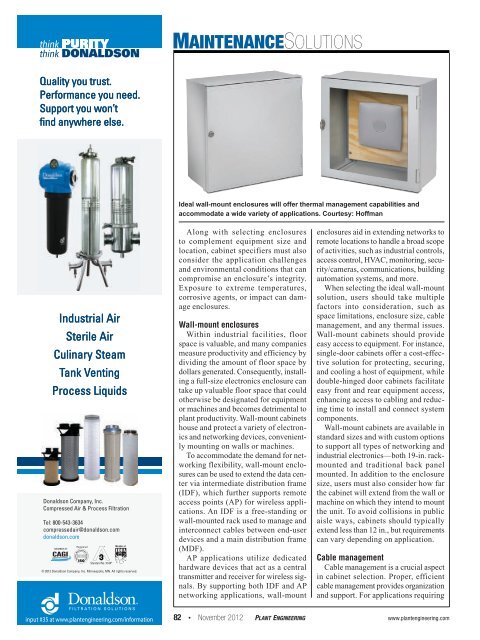2012 - PageSuite
2012 - PageSuite
2012 - PageSuite
You also want an ePaper? Increase the reach of your titles
YUMPU automatically turns print PDFs into web optimized ePapers that Google loves.
mAINTENANCESOLUTIONS<br />
Ideal wall-mount enclosures will offer thermal management capabilities and<br />
accommodate a wide variety of applications. Courtesy: Hoffman<br />
Along with selecting enclosures<br />
to complement equipment size and<br />
location, cabinet specifiers must also<br />
consider the application challenges<br />
and environmental conditions that can<br />
compromise an enclosure’s integrity.<br />
Exposure to extreme temperatures,<br />
corrosive agents, or impact can damage<br />
enclosures.<br />
Wall-mount enclosures<br />
Within industrial facilities, floor<br />
space is valuable, and many companies<br />
measure productivity and efficiency by<br />
dividing the amount of floor space by<br />
dollars generated. Consequently, installing<br />
a full-size electronics enclosure can<br />
take up valuable floor space that could<br />
otherwise be designated for equipment<br />
or machines and becomes detrimental to<br />
plant productivity. Wall-mount cabinets<br />
house and protect a variety of electronics<br />
and networking devices, conveniently<br />
mounting on walls or machines.<br />
To accommodate the demand for networking<br />
flexibility, wall-mount enclosures<br />
can be used to extend the data center<br />
via intermediate distribution frame<br />
(IDF), which further supports remote<br />
access points (AP) for wireless applications.<br />
An IDF is a free-standing or<br />
wall-mounted rack used to manage and<br />
interconnect cables between end-user<br />
devices and a main distribution frame<br />
(MDF).<br />
AP applications utilize dedicated<br />
hardware devices that act as a central<br />
transmitter and receiver for wireless signals.<br />
By supporting both IDF and AP<br />
networking applications, wall-mount<br />
enclosures aid in extending networks to<br />
remote locations to handle a broad scope<br />
of activities, such as industrial controls,<br />
access control, HVAC, monitoring, security/cameras,<br />
communications, building<br />
automation systems, and more.<br />
When selecting the ideal wall-mount<br />
solution, users should take multiple<br />
factors into consideration, such as<br />
space limitations, enclosure size, cable<br />
management, and any thermal issues.<br />
Wall-mount cabinets should provide<br />
easy access to equipment. For instance,<br />
single-door cabinets offer a cost-effective<br />
solution for protecting, securing,<br />
and cooling a host of equipment, while<br />
double-hinged door cabinets facilitate<br />
easy front and rear equipment access,<br />
enhancing access to cabling and reducing<br />
time to install and connect system<br />
components.<br />
Wall-mount cabinets are available in<br />
standard sizes and with custom options<br />
to support all types of networking and<br />
industrial electronics—both 19-in. rackmounted<br />
and traditional back panel<br />
mounted. In addition to the enclosure<br />
size, users must also consider how far<br />
the cabinet will extend from the wall or<br />
machine on which they intend to mount<br />
the unit. To avoid collisions in public<br />
aisle ways, cabinets should typically<br />
extend less than 12 in., but requirements<br />
can vary depending on application.<br />
Cable management<br />
Cable management is a crucial aspect<br />
in cabinet selection. Proper, efficient<br />
cable management provides organization<br />
and support. For applications requiring<br />
input #35 at www.plantengineering.com/information<br />
82 • November <strong>2012</strong> plant engineering www.plantengineering.com

















